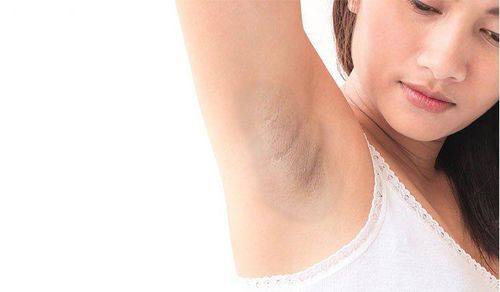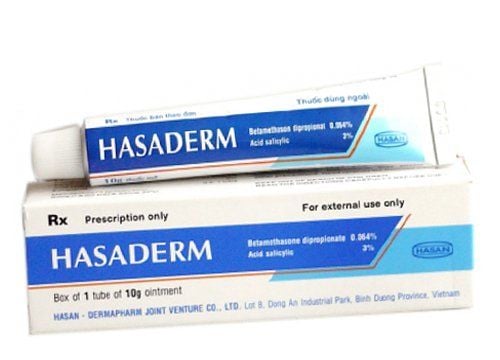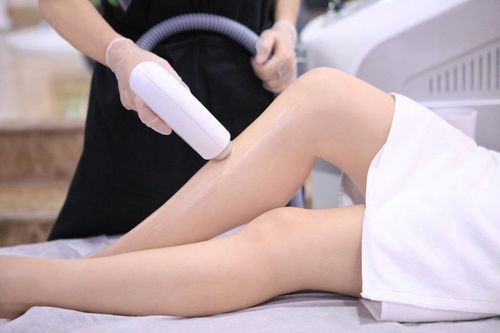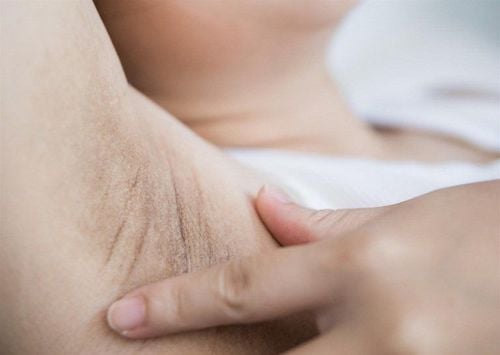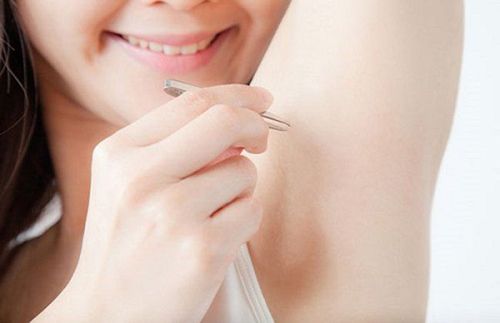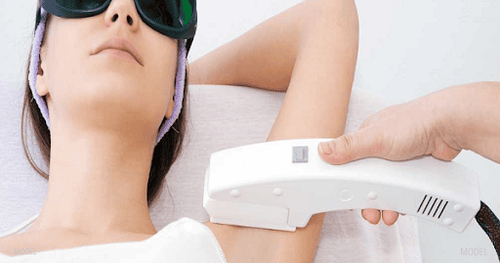This is an automatically translated article.
The removal of excessive hair growth on unwanted areas of skin is a concern of many people, especially women. There are many hair removal methods in use, including temporary hair removal and permanent hair removal.
1. The formation and growth of hair
Hair is formed from a hair unit - the sebaceous gland, located in the deep layer of the dermis. In each hair unit - the sebaceous gland contains a hair along with the hair follicle, the erector muscle, and the sebaceous gland. Hair follicles are the place where germ cells differentiate into keratinocytes and pigment cells, forming hairs of different colors and sizes. The hair is gradually pushed to the surface of the skin through the pores.
The formation and growth of hair goes through 3 stages:
Active hair state: The phase of hair growth and existence on the skin surface; Regressive hair state: The stage of hair degeneration, permanent hair loss; Feather resting state: The hairy stage is not yet developed. Depending on genetic characteristics and body development as well as foreign factors, each skin area on the body has a different distribution of hair ratio. Hair usually grows on the scalp, eyelids, eyebrows, armpits, chin, pubic and lower legs, forearms, chest, back, private areas,... Hair in an active state will be removed more easily than feathers at rest. This explains why, after permanent hair removal for active hairs, then resting hairs still grow back.
SEE ALSO: Should armpit hair be plucked, how to get rid of the bad smell?
2. Hair removal methods
There are many methods used to remove body hair. It can be divided into 2 main groups of hair removal methods:2.1 Temporary hair removal methods Hair removal
In fact, this is not a hair removal method, but a chemical method to reduce or lose hair color, causing hair loss. hairs are no longer visible on the surface of the skin. This method should only be applied to some areas of the skin with dark but thin and sparse hair. To date, few people have applied this method.
Shaving
This is the most common and simplest method to remove hair from the surface of the skin. Shaving does not make the hair darker, stiffer or grow back faster,... but after shaving, the tips of the hairs have a straight shape (not naturally tapered) so the hair usually looks more visible on the top. skin background. Shaving can last for 1 week, then the hair will grow back.
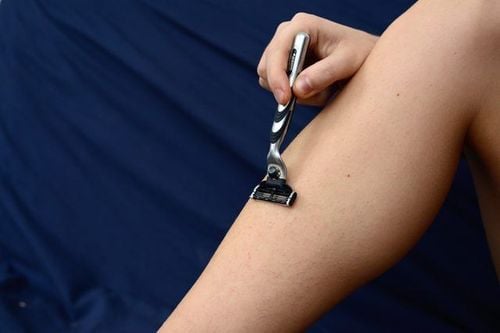
Phương pháp cạo lông thường có kết quả kéo dài trong vòng một tuần
In addition, frequent shaving with a knife in skin areas such as armpits, groin can cause skin damage, increase the risk of infection, local hyperpigmentation,... Besides, if you shave often Frequent exposure to sensitive skin areas such as the chin or intimate area is easy to cause ingrown hairs, hiding under the skin in a red, swollen pimple that can cause discomfort or pus on the skin.
Epilation
This is a simple, inexpensive method, where hair regrowth has no change in color, hardness or density. The advantage of this method is that hair regrowth is slower than shaving (because hair follicles are damaged after plucking, it takes time to regenerate) and there is a percentage of hair follicles that are damaged irreversibly. does not regrow. However, plucking hair also has the limitation of causing pain, there is a risk of causing folliculitis.
Using wax to remove hair
This method is simple, allowing to remove a large amount of hair at the same time. With this method, users use beeswax, talcum powder, vegetable acid, ... to apply on the skin, wait for it to stick to the hairs, then pull it out. Using wax to remove hair from the hair follicles, is less irritating to the skin. However, this method causes pain, and when performing, it is necessary to pay attention to the temperature of the wax when applied to the skin, to avoid burning the skin.
Using sugar for hair removal
Similar to the method of waxing hair, just replace the use of melted beeswax by using molten sugar in the form of malt to apply to the area of the skin to be removed. The hair is then pulled directly from the hair follicle.
Using depilatories
Is a hair removal method that uses a compound consisting of thioglycolate combined with calcium hydroxide (or sodium hydroxide). This compound can break the bond between skin cells and between keratinocytes, hairs will be easily broken, falling off the surface of the skin. This method is quite simple, helps to remove hair temporarily. However, this technique is easily irritating to the skin, because it acts directly on skin cells. To limit the impact of chemicals on the skin, you should only keep the medicine on the skin for a maximum of 15 minutes. If necessary, test the drug on a small area of skin for at least 48 hours before extensive hair removal.
2.2 Methods of permanent hair removal Electrolysis
This is a method that uses a very small electrode, inserted into the hair follicle and then injected with an electric current to burn, destroy the hair follicle, and prevent the formation of hair. . This method destroys each hair follicle, so it requires a lot of time to remove large areas of hair such as forearms, shins, back, chest, ... This method of permanent hair removal has the following limitations: The technique is difficult to implement. present, take a long time, pose many risks to the treated skin area (pain, infection, scarring,...);
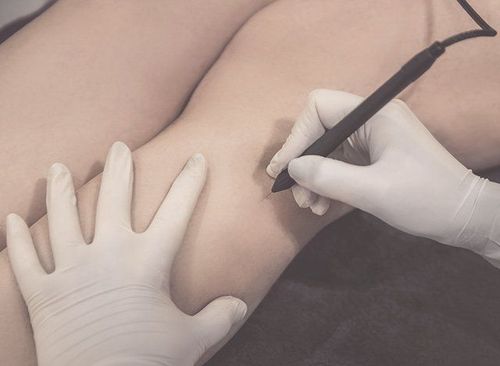
Điện phân hủy là một trong các phương pháp triệt lông vĩnh viễn
Laser and light technology
Applying the principle of selective photothermal. Because the energy of the laser and light is absorbed very strongly by melanin - which is concentrated along the hair and at the hair follicle. This process will destroy the pigment cells and germ cells of the hair follicle, destroy or weaken the hair follicle, reducing the ability to create hair. In addition, the energy of laser and light also selectively affects hemoglobin and oxyhemoglobin, blocking small blood vessels to nourish hair follicles, increasing hair follicle damage.
Types of lasers and light used in hair removal are:
Laser hair removal: Using a light band with wavelengths of 500 - 1200nm to create a hair removal laser. In addition, the laser device also needs to have a suitable pulse, ensuring that the melanin of the hair follicle absorbs the highest energy; IPL: This is a device that emits a high-intensity light beam, the wavelength range is between 610 - 1200nm, the pulse time varies from 0.1 - 1ms. In addition, IPL can be combined with RF to improve hair removal efficiency. Laser hair removal or IPL treatment usually lasts 1-7 times, each time 2-3 weeks apart. When performed, the treatment area will be shaved before treatment, cooled after treatment (with a towel or cold compress) to reduce heat damage or local irritation.
This permanent hair removal technique has high safety, no complications, no pain, high efficiency, no need to miss work or school after each treatment. At the same time, it can remove hair at the same time over a wide range. The disadvantage of laser technology, light when permanent hair removal can only remove hard hair, dark hair, long treatment time. In addition, in some cases, lasers or light can cause skin irritation, skin burns, hyperpigmentation, or scarring. At the same time, this method only removes hairs in the active state, less impact on hairs in the resting state.
Use Vaniqa cream
Vaniqa topical cream has the main ingredient eflornithine hydrochloride - of plant origin. Vaniqa has a permanent hair removal effect by inhibiting enzymes necessary for hair growth. Thereby, it makes the hair not grow further, degenerate and fall out.
When hair removal is needed, apply Vaniqa cream 5 - 15% to the skin 2 times / day, continuously for 4 - 8 weeks. This is a simple, safe and effective hair removal method, approved by the FDA.
There are many methods to remove unwanted body hair. Users should base on their needs, conditions and health to choose the optimal method.
Please dial HOTLINE for more information or register for an appointment HERE. Download MyVinmec app to make appointments faster and to manage your bookings easily.




